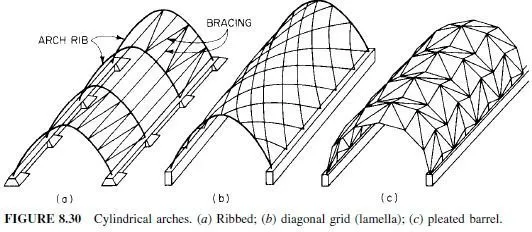High-strength steel cables are very efficient for long-span roof construction. They resist loads solely by axial tension. While the cables are relatively low cost for the load-carrying capacity provided, other necessary components of the system must be considered in making cost comparisons. Costs of these components increase slowly with increasing span. Consequently, the larger the column-free area required, the greater the likelihood that a cable roof will be the lowest-cost system for spanning the area.
Components other than cables that are needed are vertical supports and anchorages. Vertical supports are needed to provide required vertical clearances within the structure, because cables sag below their supports. Usually the cables are supported on posts, or towers, or on walls.
Anchorages are required to resist the tension in the cables. Means employed for the purpose include heavy foundations, pile foundations, part of the building (Fig. 8.32a), perimeter compression rings and interior tension rings (Fig. 8.32b). For attachment to the anchorages, each cable usually comes equipped with end fittings, often threaded to permit a jack to grip and tension the cable and to allow use of a nut for holding the tensioned cable in place. In addition, bearing plates generally are needed for distributing the cable reaction. Cable roofs may be classified as cable-stayed or cable-suspended. In a cable-stayed roof, the deck is carried by girders or trusses, which, in turn, are supported at one or more points by cables. This type of construction is advantageous where long-span cantilevers are needed, for example, for hangars (Fig. 8.32a). In a cable-suspended roof, the roof deck and other loads are carried directly by the cables (Fig. 8.32b).
The single-layer cable roof structure in Fig. 8.32b is composed of radial cables, a central tension ring, and a perimeter compression ring. Since this system is extremely lightweight, it is susceptible to wind uplift and wind-induced oscillations unless a heavy roof deck, such as precast-concrete panels, is utilized. Uplift and oscillation can be eliminated with the use of a double-layer cable roof (Fig. 8.32c) in which the primary and secondary cables are pretensioned during erection.
For a double-layer system with diagonal struts between the primary and secondary cables, truss action can be developed. If pretension is sufficiently high in the compression chord, compression induced by increasing load only decreases the tension in that chord but cannot cause stress reversal.
For both single- and double-layer systems, circular or elliptical layouts minimize bending in the perimeter compression ring and are thus more efficient than square or rectangular layouts.
Since the number of anchorages and connections does not increase linearly with increasing span, cable structures with longer spans can cost less per square foot of enclosed area than those with shorter spans. This is contrary to the economics of most other structural systems, which increase in cost per square foot of enclosed area as the span increases.
Another type of cable structure is the cable-truss dome, or tensegrity dome. It consists of a series of radial cable trusses, concentric cable hoops, a central tension ring, and a perimeter compression ring. The dome is prestressed during erection and is typically covered with fabric roofing.
Cable spacing depends on type of roof deck. Close spacing up to a maximum of 10 ft is generally economical.
For watertightness and to avoid potential problems due to roof movements at points where cables penetrate a roof, it is desirable to place cables either completely below or completely above the roof surface. If cables must penetrate a roof, the joints should be caulked and sealed with a metal-protected, rubber-like collar.
In design of cable roofs, special consideration should be given to roof movements, especially if the roof deck does not offer a significant contribution to rigidity. Care should be taken that joints in a flexible roof do not open or that a concrete deck does not develop serious cracks, destroying the watertightness of the roof. Insulation may be necessary to prevent large thermal movements. Consideration should be given also to fire resistance.
Sprinklers may be required or desirable. If the cables are galvanized, corrosion usually is unlikely, but the possibility should be investigated, especially for chemically polluted atmospheres.
(See Art. 4.10.)




